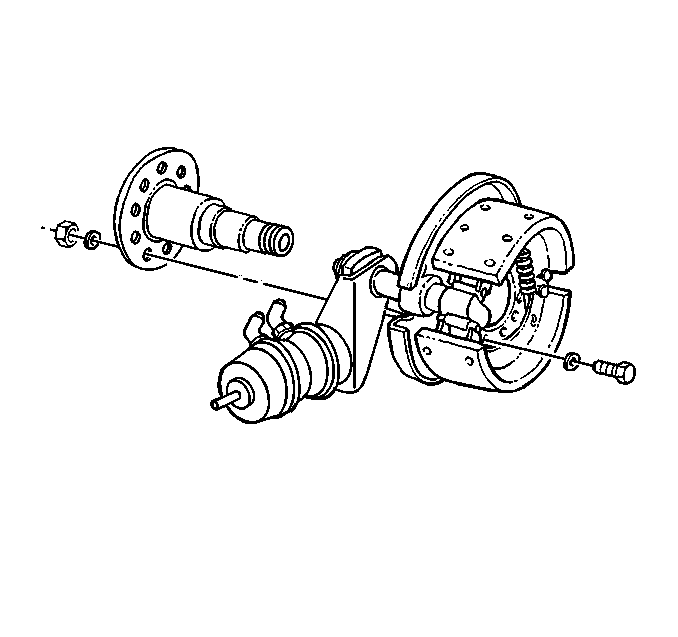Rear Cam Brake Assembly Replacement right
Removal Procedure
- Block the wheels.
- Raise and support the rear axle with safety stands. Refer to Lifting and Jacking the Vehicle in General Information.
- Cage the rear air brake chamber. Refer to Caging the Rear Air Brake Chamber .
- Drain all air reservoirs. Refer to Draining Reservoirs in Air Brakes.
- Remove the tire and wheel assembly. Refer to Tire and Wheel Removal and Installation in Tires and Wheels.
- Remove the brake drum. Refer to Brake Drum Replacement .
- Remove the hub assembly. Rear Axle Hub, Bearing, Cup, and/or Seal Replacement in Rear Drive Axle.
- Remove the air line from the rear air brake chamber. Refer to the appropriate procedure in Air Brakes:
- Remove the wheel speed sensor, if equipped. Refer to Rear Wheel Speed Sensor Replacement in Antilock Brakes System.
- Remove the bolts and the washers.
- Remove the rear brake assembly from the rear axle.

Caution: Avoid taking the following actions when you service wheel brake parts:
• Do not grind brake linings. • Do not sand brake linings. • Do not clean wheel brake parts with a dry brush or with compressed air.
Installation Procedure
- Install the rear cam brake assembly to the rear axle.
- Install the washers and the bolts.
- Install the wheel speed sensor, if equipped. Refer to Rear Wheel Speed Sensor Replacement in Antilock Brake System.
- Install the air line to the rear air brake chamber. Refer to the appropriate procedure in Air Brakes:
- Install the hub assembly. Refer to Rear Axle Hub, Bearing, Cup, and/or Seal Replacement in Rear Drive Axle.
- Install the brake drum. Refer to Brake Drum Replacement .
- Adjust the rear wheel bearings, if needed. Refer to Rear Axle Hub, Bearing, Cup, and/or Seal Replacement .
- Install the tire and wheel assembly. Refer to Tire and Wheel Removal and Installation in Tires and Wheels.
- Remove the safety stands and lower the vehicle. Refer to Lifting and Jacking the Vehicle in General Information.
- Start the engine.
- Charge the air system to the air compressor governor valve cut-out point.
- Check for proper brake operation.
- Stop the engine.
- Apply the parking brake.
- Remove the wheel blocks.

Notice: Use the correct fastener in the correct location. Replacement fasteners must be the correct part number for that application. Fasteners requiring replacement or fasteners requiring the use of thread locking compound or sealant are identified in the service procedure. Do not use paints, lubricants, or corrosion inhibitors on fasteners or fastener joint surfaces unless specified. These coatings affect fastener torque and joint clamping force and may damage the fastener. Use the correct tightening sequence and specifications when installing fasteners in order to avoid damage to parts and systems.
Tighten
Tighten the rear cam brake assembly bolts to 220 N·m (162 lb ft).
